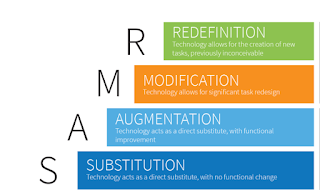Higher Order Thinking & the SAMR Model
Secondary discipline areas are often content-laden. Use Robyn Collins Curriculum and Leadership as a foundation, and consider the Australian Curriculum in your selected junior discipline area. Identify the process/research/inquiry skills that are required. They are skills that, according to Collins, are best developed through application to real-life contexts. Use the Aims, rationale and structure of the curriculum to uncover the global approaches of importance, as well as the content.
My discipline areas are Physical Education and Home Economics. In Physical Education (PE) students are required to use inquiry based learning which means they are involved in their learning, formulating questions, investigate widely and build new understandings, meanings and knowledge. The skills required in PE are formulating questions, gathering and organizing, interpreting and analyzing, evaluating and drawing conclusions, communicating and reflecting. These are all research and inquiry skills that are paramount to succeeding in PE. According to Collins (2014), teachers are expected to use high order thinking which is subcategories into three sections. The one relevant to PE is the transfer category. This category promotes retention and transfer, which when it occurs indicates meaningful learning. Retention requires students to remember what they have learnt, whereas transfer requires student not only to remember but also to make sense of and be able to use what they have learned i.e. sport or real life.
References: Collins, R.
(2014) Skills for the 21st Century: teaching higher-order thinking. Curriculum
Leadership and Journal. Retrieved from http://www.curriculum.edu.au/leader/teaching_higher_order_thinking,37431.html?issueID=12910
Write a reflection that draws together Blooms
Taxonomy, your understanding of ICT pedagogy and the SAMR model as it relates
to your teaching context. Rather than think about what you have
experienced in schools, try to take an aspirational position on this
reflection. Examine not what currently exists, but what is possible. This will become the foundation of
your own pedagogical framework which will later be mapped against a learning
design.
It is clearer now
how technology effects our everyday lives. It is a vital aspects to our
development as educators but also our students future development. Blooms
Taxonomy explains how learners need to have the ability to remember,
understand, apply, analyze, evaluate and create. This can be applied in any learning
space and teaches students basic learning skills that are vital to their
development. This framework uses the key aspects to show students how to use
technology and digital tools to facilitate their learning and outcomes. The
SAMR model has the same foundation where it is helping teachers understand how
to develop their use of ICT in the classroom so it has a positive effect of
student learning. SAMR stands for, Substitution, Augmentation, Modification and
Redefinition. The higher you get on the SAMR model the more actively you are using ICT's. With the use of
these frameworks we can slowly build schools use of ICT's and better student
development. Students are usually given the information, instead of making them
critical thinkers and sourcing it themselves. We need to give our students more
responsibility, with the development of ICT's by challenging them.


Comments
Post a Comment